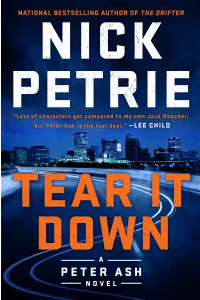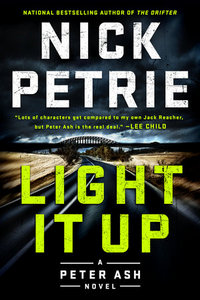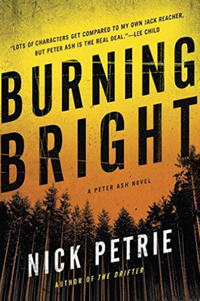
“I could really use your help,” Henry told Peter. “Maybe a week, two at the most. Just until I get things squared away,”
Peter didn’t have to think before he answered.
“No problem.” He’d send June a postcard. Maybe leave out a few details. He didn’t want to worry her. “Sign me up.”
Later, he’d wish he’d answered differently.
He’d have plenty of reasons.
But he knew he’d have answered exactly the same way.
What’s Light It Up About?
Peter meets and befriends a Vietnam vet on a project in Oregon. His friend, Henry, needs to return home to Denver—his daughter and son-in-law run a security company, escorting money for the cannabis industry. On a recent run, the son-in-law and his team went missing (along with the money). Henry needs to go help run things and hopefully come across a clue about the disappearance. He asks Peter to come along, and he does.
Four days later, Henry, Peter, and two others are taking care of another shipment of money. It’s a very routine run—until it’s not. They’re attacked by a group of professionals and it’s a very ugly event.
It’s no longer about Peter trying to help out a friend, it’s now about Peter striking back at the people who attacked his team and making sure they don’t do anything like that again.
A Three-Headed Monster
There are essentially three villains to this book. I’d like to talk about all three of them, but I don’t think I really can without taking something away from the experience—one calls the shots, one is the man on the ground making the plans and seeing that they’re implemented, the third is the guy who carries out the plan.
This latter we’ve seen before—he’s all about killing and raping*—maybe a little pillaging while he’s at it. He really just wants to watch the world burn. The man at the top is another guy we’ve seen before (a good version of him, don’t get me wrong).
* No, he doesn’t rape anyone in this book. There are some passing references to times he has, and he definitely looks forward to doing it in the future.
It’s the middle man that’s the guy who captured my attention. The man at the top is probably convinced he’s doing the right thing (for at least some people), the guy at the bottom of the chain of command doesn’t care about right and wrong. But the other one—he knows that what he’s doing is wrong, he is deliberately choosing evil. He has compelling reasons for that, but he’s going in with his eyes wide open.
Also, he has an interesting tie to Peter, one that adds a new layer to Peter.
No Army of One
Peter likes to think of himself as a lone wolf—he can do it all himself. Maybe even thinks he needs to (the book delves deep into this toward the end, but I’m not interacting with that part). But he’s not one—unlike Jack Reacher (the easiest guy to compare him to) who will pick up an ally or two for a book, and then will leave them in the dust while “The Lonely Man” (from The Incredible Hulk) plays in the background.
Peter didn’t want to leave June behind, but needed to (and wants to get back to her). And while he considers Lewis a friend, doesn’t try to get him involved in his messes. But they don’t let him—he needs help, so they come to him, over his objections.
Peter’s an action hero for our time—he’s dealing with PTSD (not stoically enduring, he’s trying to deal with it, he’s got a counselor), he has a sense of humor, and he’s a social creature. He needs people—for community and for assistance from time to time—and he’s the kind of guy that people are drawn to.
There’s a moment where Lewis describes why Peter’s men followed him where they did in Iraq. It’s something about his personality, is leadership, his character—he still has that, he just has different people following him in the trouble spots in the U.S.
The Lone Wolf Hero is a mainstay, it’s a fixture in Fiction—but a hero like Peter? He’s so much easier to believe. Easier to root for. He has more to lose, so you care more for his success.
A Missed Opportunity
When it looks likely that Peter’s going to be facing some legal troubles, Lewis arranges for a lawyer for him. She comes on the scene like some sort of oversexed Rita Fiore (from the Spenser/Jesse Stone series), intimidating police and protecting Peter. She’s not cartoonish, but she’s trending that way. She has a couple of good scenes, but then she practically vanishes.
This isn’t a legal thriller, and a lawyer shouldn’t play a huge role—but if you’re going to put a flashy character show up, use them. There’s no reason to believe that she’ll be around in future books—unless Peter moves to Denver.
I did like her, I thought she had some good scenes, but it felt like hiring Meryl Streep to play a role listed as “Lady in Restaurant” in the credits.
So, what did I think about Light It Up?
This series gets better and better. I thought the whole idea of the security for the cash shipments for the new (at least then) cannabis industry in Colorado was great. It’s the kind of thing that was just waiting for a thriller writer to jump on, and Petrie took full advantage before anyone else saw it.
There’s a mano a mano fight at the end—fantastic. Just fantastic. There’s plenty of action before that—a chase scene, the ambush of the security team, and some others—just those would’ve been enough to make me commend and recommend this thriller. But that climactic combat? Just wonderful.
Like with Burning Bright, I lost sleep over this—and did not care. Solid (at least) action, an ingenious premise, good character development, some well-written and well-conceived antagonists (scratch that, they’re flat-out bad guys). There’s nothing to complain about here. Get your hands on this one.

This post contains an affiliate link. If you purchase from it, I will get a small commission at no additional cost to you. As always, opinions are my own.

 This is a weekly bloghop hosted by Freda’s Voice.
This is a weekly bloghop hosted by Freda’s Voice. Grab a book, any book.
Grab a book, any book. Turn to Page 56 or 56% on your ereader. If you have to improvise, that is okay.
Turn to Page 56 or 56% on your ereader. If you have to improvise, that is okay. Find a snippet, short and sweet.
Find a snippet, short and sweet. Post it
Post it

![]()






 At multiple points both Peter and June note that Peter’s having fun when it’s dangerous, when things are violent, when the bullets are flying. As a reader, this is great—you don’t see Reacher, Charlie Fox, Evan Smoak, etc. enjoying things quite like this. But I’m a little worried about what it says about him as a person.
At multiple points both Peter and June note that Peter’s having fun when it’s dangerous, when things are violent, when the bullets are flying. As a reader, this is great—you don’t see Reacher, Charlie Fox, Evan Smoak, etc. enjoying things quite like this. But I’m a little worried about what it says about him as a person.
